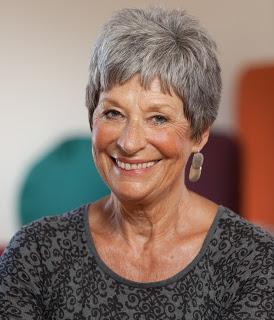
Winter Trees by Melina Meza
When my mother died at 84 from complications of a stroke she had two years before, her earthly belongings fit neatly into a small brown box, about 18 inches square. Slippers, a couple of sets of underwear, and three nightgowns and robes were all she had left at the end. That visual had a visceral impact on me. A long life lived, and. . . . this was it?Of course, the brown box was preceded by selling her home after it became apparent she would not return. My brother and sister-in-law shouldered the tedious work of sorting, and determining the fate of a lifetime of mementos, collections, art, furniture, clothing, kitchen items, shoes, and jewelry. They sold some and gave much of it away. But now at 65, they have a good portion of mom’s belongings in their attic, along with their own considerable collection of family belongings. This story is being played out in millions of families, all of us drowning in a sea of stuff.
If that situation sounds familiar, it’s timely to explore and experience the lessons of aparigraha (greedlessness). One of the five yamas (or moral guidelines) of classic yoga philosophy, aparigraha reminds us to keep our desire for possessions to what is only necessary or important. Aparigraha invites us to examine the “I want” response we feel when we are tempted to acquire something new (and unnecessary). Learning about and adopting the principles of aparigraha can help us find happier, more focused lives—if we are willing to actually practice letting go, needing less, and shedding possessions. But, as many of us discover, paring down is much easier said than done.
It seems we are hungering for and reconnecting with the need for a sense of order in our lives. Author and presenter Marie Kondo (The Life-Changing Magic of Tidying Up: The Japanese Art of Decluttering and Organizing and Spark Joy: An Illustrated Master Class on the Art of Organizing and Tidying Up) has made a hugely successful business telling us how to organize, edit, and/or get rid of belongings. The goal is to become liberated from “too much stuff” so it’s possible to live much more satisfying lives. Looking through that lens, it may be time to take a deep breath, carefully consider what we’ve got, and take the plunge of lightening up.
Where Did All this Stuff Come From?
In our older years, it can be daunting to survey and inventory a lifetime of memorabilia, antiques, and odds and ends we’ve stashed away but don’t ever throw out. We humans are avid collectors, too. Look around at the vast, often beautiful and wonderful collections we amass—from art glass to shells to angels to thimbles to antique furniture, photographs, and vintage automobiles. Our collections can be wonderfully fun to grow over the years, but getting older, we become more aware that our collections will need a home somewhere, some day, when we are no longer around to care for them.
Then there are all the things we inherit, intentionally or not, from immediate family and friends. When mom dies, somebody has to manage her sets of china and collection of cut glass, and when we are pressed by other demands, it often doesn’t get handled. Consequently, we have attics and basements and rented storage areas filled with the possessions of our deceased parents and friends, our adult children, and ourselves.
Finally, contemporary marketing and advertising entice us with tempting possibilities, from small (a new tube of lipstick) to significant (luxury yachts and expensive wardrobes). Our possessions define us, tell a story, and paint a picture of who we are and what we value. As a result they start to own us, and it is hard to think about paring back.
Aparigraha in Practice
In a culture of consumerism, where algorithms keep track of how we shop—where and when and what we buy and how much—aparigraha can be antidote to our constant desire for new things. But letting go of precious and sentimental items—children’s first grade artwork and report cards, birthday and holiday cards, photos, scrapbooks—can be especially difficult. However, that’s not an argument for not doing it. Aparigraha extends the opportunity to release all that is not necessary and enjoy the rewards of lightness. And with a steady approach to it, we can change our relationship to our stuff. Sometimes the mere act of beginning sets intention in motion.
A technique that helps me release items that no longer serve—even if they are loaded with heart-warming memories—is my “lost it in the fire” strategy. I concocted an inner story where my house burned down and every non-living thing I owned or treasured was lost—a situation plenty of people face in real life. In my story, I dealt with the loss of all those irreplaceable items (including remembering them fondly and mourning them), and then I moved on, knowing I’d never see them again.
That technique helped during a recent cross-country move after 28 happy years in California. I couldn’t duck it any longer—there was a lot of stuff that had to be dealt with. The move spurred a flurry of aparigraha-inspired actions: giving away, selling, and otherwise getting rid of so many belongings, including a storage area’s worth of stuff that had been sitting there for 13 years, with only occasional visits to retrieve something. I came across four boxes of spiral notebooks, journals I’d kept since my early thirties but never looked at. I’d been lugging these boxes around for so many years, for what exactly? At last I tossed them, along with many other belongs that once had “meaning,” and thought, “I lost them in the fire.” And I haven’t missed anything since.
Considering my mother’s brown box opened me to the deep lessons in aparigraha that were to follow. I learned a lot preparing for a six-week trip to India, with only a small yoga backpack for luggage. Somehow, I managed fine with just the very basics. I learned a lot living in an Indian ashram for a month in Spartan accommodations that were not at all comfortable—but I had all that was necessary.
With aparigraha as my north star, such experiences help me closely examine my habits of consumption and support my mantra: Enough bright, shiny objects. As a result, not only do I have more in the bank account, I have more peace of mind and lightness of being.

Subscribe to Yoga for Healthy Aging by Email ° Follow Yoga for Healthy Aging on Facebook ° Join this site with Google Friend Connect

